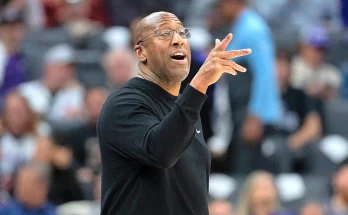The basketball world never sleeps, and the offseason has already been rife with speculation about player movements and team strategies. One of the most intriguing storylines swirling around the NBA involves Boston Celtics veteran Al Horford and the possibility of him carving out a role with the Golden State Warriors. Known for his steady leadership, defensive acumen, and versatility on the court, Horford has been a cornerstone for the Celtics for years. His presence in Boston has been instrumental in their championship pursuits, particularly with his ability to anchor the defense, space the floor with timely shooting, and mentor younger players. Yet, whispers of a potential shift to the Warriors have begun to gain traction, sparking intense debates among analysts, fans, and insiders about what Horford’s role could look like in Golden State, how he might fit within Steve Kerr’s system, and the broader implications for both franchises.
Al Horford’s career trajectory has always been defined by adaptability. Entering the NBA as the third overall pick in the 2007 draft, he quickly distinguished himself as a fundamentally sound big man with a rare combination of size, shooting touch, and defensive intelligence. Over the years, Horford has consistently demonstrated a capacity to impact games without necessarily filling the highlight reels. He excels in the subtle aspects of basketball: positioning on defense, making the right pass at the right time, setting screens that free shooters, and being a reliable option in late-game situations. His tenure with the Celtics has only enhanced his reputation as a high-IQ player, capable of fitting into complex schemes while still exerting influence on both ends of the floor.
The Golden State Warriors, on the other hand, have spent the past decade building a dynasty rooted in pace, space, and exceptional shooting. Under Steve Kerr’s leadership, the Warriors have perfected a system that thrives on ball movement, off-ball cutting, and positional versatility. They have demonstrated an uncanny ability to integrate new pieces into their roster, often maximizing individual strengths while maintaining a cohesive team identity. The addition of someone like Al Horford could provide a stabilizing veteran presence while also giving the Warriors additional flexibility in rotations and lineups. However, it would require careful orchestration to ensure that Horford’s skill set complements, rather than conflicts with, Golden State’s established tempo and offensive patterns.
One of the most obvious contributions Horford could make to the Warriors is his defensive versatility. Over the years, he has guarded multiple positions, from agile wings to traditional big men, often switching seamlessly without disrupting team schemes. This quality would be invaluable for Golden State, particularly against Eastern and Western Conference teams that increasingly rely on small-ball lineups and hybrid forwards. Horford’s ability to read plays, anticipate passing lanes, and make timely rotations could allow the Warriors to maintain their defensive identity even while experimenting with unconventional lineups. Furthermore, his presence would allow Draymond Green to focus more on facilitating the offense, knowing that there is another reliable defender to anchor the paint.
Offensively, Horford brings a polished skill set that meshes well with Golden State’s spacing philosophy. His ability to stretch the floor with consistent mid-range shooting and occasional three-point bursts would create more room for shooters like Stephen Curry and Klay Thompson to operate. Beyond shooting, Horford is also an adept passer from the high post and can function as a secondary playmaker, which could ease the offensive burden on Golden State’s primary ball-handlers. His proficiency in pick-and-roll situations would be particularly useful when integrating younger players or adjusting to in-game matchups. Horford’s offensive intelligence ensures that he doesn’t need the ball constantly to make a meaningful impact—a trait that aligns perfectly with the Warriors’ free-flowing offensive system.
Another aspect to consider is Horford’s intangible leadership qualities. Over the course of his career, he has been praised for mentoring younger players, fostering team chemistry, and maintaining composure in high-stakes moments. The Warriors, despite their championship pedigree, could benefit from an experienced voice in the locker room, especially with a mix of emerging talent and established stars. Horford’s presence could serve as a stabilizing force, offering guidance during tense playoff situations or helping younger wings understand defensive rotations and offensive spacing. The impact of such mentorship is often underappreciated in statistical analyses, but it can be crucial for sustaining a championship-contending culture over multiple seasons.
However, integrating Horford into Golden State’s rotation would not be without challenges. At 37 years old, his mobility is not what it once was, and the Warriors’ system demands high-level agility and endurance, particularly in transition defense. Kerr would need to carefully manage minutes and matchups to ensure that Horford remains effective without compromising team speed. Additionally, Horford’s tendency to thrive in half-court sets could require some adjustments from both him and his teammates, as Golden State often relies on constant movement and spacing to generate open looks. Balancing these elements would be key to maximizing his impact without diminishing the team’s identity or rhythm.
The potential ripple effects of Horford joining the Warriors extend beyond the court. For Boston, losing a veteran of Horford’s caliber would signify a major shift in leadership dynamics and roster construction. While the Celtics have younger stars capable of shouldering more responsibility, Horford’s departure could leave a void in terms of experience, defensive acumen, and mentorship. Conversely, for Golden State, adding Horford could signal a strategic pivot toward blending seasoned veterans with their high-octane style, potentially enhancing depth and providing a more balanced approach to playoff basketball. It’s a move that could make the Warriors more resilient in late-game scenarios while giving them additional options for defensive matchups against elite forwards and big men.
From a broader perspective, Horford’s presumed role with the Warriors raises interesting questions about how veteran players can adapt in the modern NBA. Increasingly, teams are valuing positional flexibility, high basketball IQ, and the ability to contribute in nuanced ways over raw athleticism. Horford embodies these traits, and his potential transition from Boston to Golden State exemplifies how experienced players can extend their careers by embracing complementary roles. In a league that is continually evolving toward pace-and-space, switching defenses, and perimeter shooting, Horford’s adaptability makes him a valuable asset, even if he is no longer the primary star on a roster.
Furthermore, the narrative surrounding Horford’s possible move highlights the strategic chess game that defines NBA roster building. Teams must constantly balance immediate championship aspirations with long-term development, blending youthful athleticism with seasoned decision-making. Golden State, with its mix of established stars and emerging talent, represents a perfect environment for Horford to demonstrate that a veteran presence can still significantly influence outcomes, even without dominating traditional statistical categories. His role may be subtle, but it could be critical in determining the Warriors’ success in high-stakes playoff scenarios where execution and experience often trump sheer talent.
Fans and analysts have speculated extensively on what Horford’s minutes, lineup positioning, and usage might look like. Some envision him as a defensive anchor paired with Kevon Looney in small-ball lineups, providing a low-post presence while still allowing perimeter defenders to roam. Others see him as a secondary facilitator who moves the ball, sets screens, and creates spacing for shooters—a role that could prolong possessions and generate open looks in crunch time. While the exact blueprint remains uncertain, it is clear that Horford’s multifaceted skill set allows for a variety of potential fits, each offering strategic advantages that could elevate Golden State’s performance in key matchups.
Ultimately, Al Horford’s presumed role with the Golden State Warriors represents more than just a roster addition; it embodies the convergence of experience, adaptability, and basketball intelligence in a modern NBA context. His potential contributions on defense, spacing, playmaking, and leadership underscore how veteran players can remain relevant and influential in high-level team systems. While challenges exist, particularly in terms of mobility and minutes management, the opportunity for Horford to integrate into a championship-contending team like Golden State is compelling. The narrative captures the imagination of fans, analysts, and players alike, highlighting the enduring value of intelligence, adaptability, and composure in a league increasingly dominated by athleticism and pace. If this move materializes, it will not only redefine Horford’s career trajectory but also offer a fascinating case study in how seasoned veterans can continue to shape the fortunes of elite NBA teams. The anticipation surrounding his potential role is palpable, and all eyes will be on the Warriors’ training camp and early-season rotations to see how this intriguing experiment unfolds.
The combination of Golden State’s offensive ingenuity and Horford’s seasoned presence could produce a unique synergy, allowing the Warriors to maintain their high-octane style while benefiting from the subtle yet impactful contributions of a veteran forward. As the NBA continues to evolve, Al Horford’s prospective journey from Boston to the Bay exemplifies the enduring importance of versatility, experience, and basketball IQ—qualities that are increasingly vital in shaping modern championship contenders.


